Isn’t it about time you owned the conversation in your industry by turning every piece of content into a lead-generating machine? If your current content strategy isn’t fueling growth, it’s a liability. Let’s change that.
B2B SaaS buyers are sceptical, overwhelmed, and short on time.
Your content has to engage them immediately and lead them down the path to choosing a solution — yours.
B2B SaaS content marketing plays a crucial role in shaping future trends and specialised content strategies for distinct audiences.
Today, you’ll learn how to finally take charge of your content strategy for SaaS by learning:
- How to craft a SaaS content strategy that aligns with your business goals and drives measurable growth.
- The key elements your content must include to build trust, generate leads, and boost conversions.
- Actionable steps to optimise your content for SEO, positioning your brand as the go-to solution in your market.
And most importantly, you’ll also learn how to create a content marketing strategy that aligns with your business goals and drives long-term growth.
But before we dive into the steps, let’s clarify what a SaaS content strategy actually is and why it’s unique.
What is a SaaS content strategy?
A solid SaaS content strategy is the backbone of sustainable growth. But what does it really mean to have one? Let’s break it down by defining what sets SaaS content strategies apart from the rest.
Defining SaaS content strategy
Your business shouldn’t be blogging for the sake of it. You want to know exactly what your target audience is looking for and deliver it at every stage of their buyer’s journey.
Your content must be something they can’t ignore — something they know only you can provide.
SaaS buyers are proactive, meticulous, and definitely not impulsive. And winning them over is a long game. You’re playing for:
- Trust: Prospective customers need to feel that you understand their challenges better than anyone else.
- Engagement: Your content should offer real solutions every step of the way.
- Conversion: Make it easy for them to choose you over the competition.
What makes a B2B SaaS content strategy different? It’s all about the long-term. SaaS strategies focus heavily on nurturing leads, optimising for SEO, and showcasing how your product solves specific problems.
Remember! Unlike other industries, where content might be short-lived, SaaS content needs to be evergreen, continually driving engagement and conversions.
A solid content strategy isn’t just about keeping up with competitors; it’s about creating a long-term advantage. A well-rounded B2B SaaS content marketing strategy not only aids in lead nurturing but also fosters long-term customer relationships. So, why exactly do SaaS companies need one?
Why SaaS companies need a content strategy
SaaS is built on scalability, but you’re leaving growth to chance without a strategic content plan. Content isn’t just another marketing tool—it’s the backbone of driving organic traffic, generating qualified leads, and keeping your sales pipeline full.
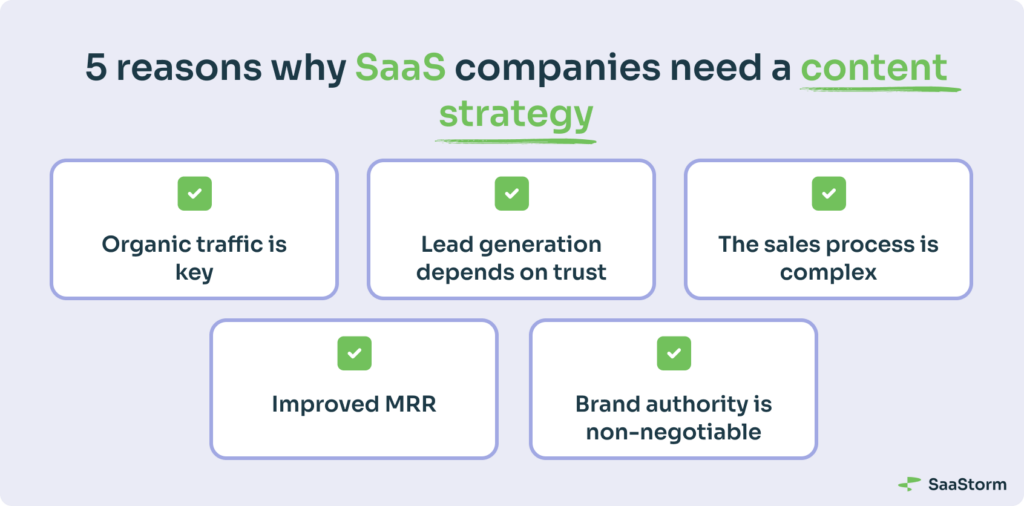
A strong content strategy is critical because:
- Organic traffic is key
SaaS companies thrive on organic reach. Paid ads can only take you so far, and the cost is unsustainable without an evergreen content plan.
- Lead generation depends on trust
The more valuable and consistent your content, the more likely you are to build a pipeline of leads that truly convert. Ironing out your B2B SaaS demand generation strategies can nurture trust and drive more qualified leads to your pipeline.
- The sales process is complex
SaaS buyers go through multiple touchpoints before making a decision. Your content should align with each stage of this journey, answering questions before they’re asked and clearing the path for your sales team to close the deal.
- Improved MRR
The right B2B SaaS content marketing strategy can directly impact your monthly recurring revenue. By continuously engaging prospects and customers, you increase retention and expand account growth.
- Brand authority is non-negotiable
In such a competitive space, positioning your brand as a thought leader is what will keep your audience coming back. A solid content strategy consistently demonstrates your expertise and value.
Remember! Without a content strategy, you’re missing out on all of these long-term benefits and risking stagnation in both traffic and growth.
Now that we’ve covered the importance of having a SaaS content strategy let’s break down the essential components that make it successful.
Key components of a SaaS content strategy
Your content has two jobs:
1. Boost visibility
2. Drive leads
A successful approach starts with creating a content strategy that outlines exactly how to achieve these goals.
To boost visibility and drive leads, you have to do two things before mapping out your strategy:
Defining your business goals
Defining your business goals is the first step in creating a successful SaaS content marketing strategy. Your goals should be specific, measurable, achievable, relevant, and time-bound (SMART).
For example, your goal might be to increase organic traffic by 20% in the next six months or to generate 50 new leads per month through your blog.
Having clear goals in mind will help you focus your content marketing efforts and measure the success of your strategy.
Identifying your target audience
Identifying your target audience is crucial for creating content that resonates with them.
You need to understand their pain points, goals, and behaviours to create content that addresses their needs.
Conduct customer research, analyse your website analytics, and use social media listening to gather insights about your target audience. Create buyer personas to help you visualise your ideal customer and guide your content creation.
Understanding how to create a B2B content strategy ensures your marketing efforts resonate with your audience and drive measurable outcomes.
If you get stuck, partnering with a B2B SaaS marketing agency can help ensure your messaging aligns with audience needs and drives measurable results.
Now that you’ve covered the fundamentals, here are the four ways you can be intentional with your content strategy:
Content writing
High-quality content isn’t just about hitting publish. It’s about educating your audience and addressing their pain points head-on. Your content needs to make your audience feel understood, offer solutions, and nudge them toward conversion.
When creating a blog content strategy, the key is to ensure that each post provides value and moves your audience closer to conversion.
When you consistently deliver value through educational content, you’re not just generating leads but building long-term trust.
Need help with B2B SaaS content writing? Let’s chat!
Schedule a CallCreating a content lifecycle strategy
A content lifecycle strategy involves mapping out all the content needed to produce across the customer journey. This includes content for awareness, consideration, and conversion stages.
Your content should be created to speak to your target audience and convert well.
Use a content calendar to plan and organise your content, and consider creating a mix of content types, such as blog posts, social media posts, email newsletters, and video content.
SEO
If you’re not optimising your content for search engines, you’re missing out on potential traffic. Knowing how to create a blog content strategy incorporating SEO best practices is critical to boosting visibility.
SaaStorm can help you with your B2B SaaS SEO strategy!
Schedule a CallSearch engine optimisation (SEO) is the backbone of a strong content strategy. From keyword research to on-page optimisation and backlinks, understanding how to create an SEO content strategy ensures your content gets seen by the right people at the right time.
Check out our B2B SaaS SEO guide to learn how to optimise your content and boost visibility
Now that we’ve covered the essential components of a successful SaaS content strategy let’s look at some best practices that will take your content strategy to the next level. These are the steps that separate average strategies from the ones that truly deliver results.
Best practices for creating a SaaS content strategy
Even with the right components in place, your winning content marketing strategies for SaaS need a solid foundation of best practices to truly succeed.
Creating a successful content marketing strategy requires attention to your audience’s needs and consistent execution.
Here’s how to ensure your content strategy stands out and delivers results:
Prioritise quality over quantity
When considering how to create a good content strategy, focus on delivering high-quality, value-driven content consistently.
Instead of flooding your blog with content that doesn’t resonate, focus on creating fewer but more impactful pieces. Here’s how:
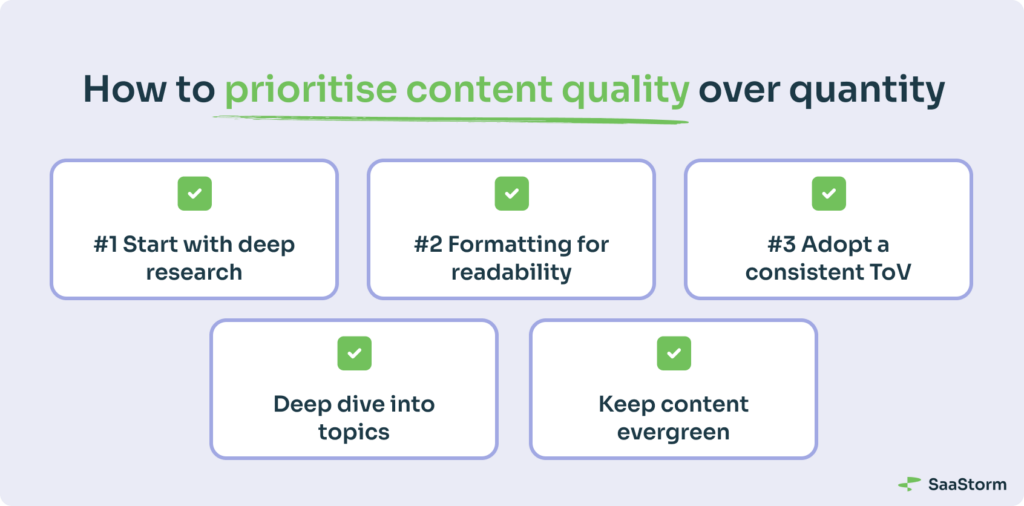
#1 Start with deep research
High-quality content begins with understanding your audience’s needs and problems using keyword research tools like Ahrefs, Moz, and SEMrush.
Use these tools to analyse what your audience is searching for, what competitors are ranking for, and any content gaps you can fill. Beyond keyword research, focus on:
- Customer surveys and interviews: Gain insights directly from your existing customers. What challenges do they face that your product solves?
- Industry reports and data: Use reports and case studies from trusted sources to back up your claims and enhance credibility.
#2 Formatting for readability
Great content is easy to consume. Follow these guidelines to improve your content’s readability:
- Use headers and subheaders: Break up long sections with headers (H2, H3) to guide the reader and make the content scannable.
- Short paragraphs: Keep paragraphs short (2-3 sentences max) to maintain reader engagement.
- Bullet points and lists: Use bullet points and numbered lists to organise information clearly.
#3 Adopt a consistent, authoritative tone of voice
SaaS buyers are looking for expertise, so your content needs to reflect authority. Here’s how to develop a confident tone:
- Address pain points: Speak directly to your audience’s challenges and offer practical solutions. Don’t be afraid to share bold opinions or unique insights.
- Maintain consistency: Your tone should be consistent across all platforms—whether it’s blogs, case studies, or emails—to build trust over time.
#4 Deep dive into topics
Rather than surface-level posts, go in-depth. Create long-form, well-researched pieces that fully cover a topic, providing value others aren’t offering.
#5 Keep content evergreen
Write content that will remain relevant over time. This means avoiding trends that fade quickly and focusing on the core challenges your audience will face for years.
Want to see how high-quality content resonates with audiences? Explore these successful SaaS content marketing examples that show how effective content can drive engagement and conversions.
Repurpose existing content for different channels
Creating content from scratch isn’t always necessary. Part of this approach involves knowing how to create a digital content strategy that spans multiple platforms and channels.
This allows you to maximise the value of your best-performing assets.
Here’s how to do it effectively:
#1 Tailor content for each platform
Every platform has a unique audience and content style, so what works for a blog post might need tweaking for LinkedIn or YouTube. Here’s how to repurpose content across platforms:
- For Blogs: Expand existing social media posts or video scripts into comprehensive blog posts. Dive deeper into the subject with more research, statistics, and analysis.
- For LinkedIn: Break down blog posts into bite-sized insights or create engaging conversation starters. LinkedIn audiences value quick tips or concise, valuable takeaways.
- For YouTube: Turn long-form blog content into engaging videos or tutorials. Use visuals, screen recordings, or animations to explain complex ideas simply.
🛠️ Tool Recommendation: Loom
Use Loom to create quick video walkthroughs of blog content or case studies, especially for SaaS products that benefit from visual explanations.
#2 Automate and schedule repurposed content
Once you’ve repurposed content, automation tools can help you schedule it across various channels efficiently:
- Use Hootsuite or Buffer: Schedule social media posts ahead of time and automate the sharing of blog snippets or quotes from case studies.
- Email Campaigns: Tools like Mailchimp or HubSpot allow you to repurpose blog content into email campaigns that keep your audience engaged with valuable updates and insights.
Focus on long-term relationships, not quick wins
Building lasting trust with your audience will pay off more in the long run than one-off sales. Here’s how to nurture those relationships:
- Create a content journey: Map out content for each stage of the buyer’s journey. This ensures you deliver the right value at the right time, whether they’re learning about your product or ready to purchase.
- Use email nurturing campaigns: Send regular, value-packed emails to your prospects to keep them engaged over time, reminding them of your solutions without being overly salesy.
- Offer consistent value: Instead of pushing for a sale in every interaction, offer insights, tips, and resources that help your audience. The more value you provide upfront, the more trust you build.
With these best practices in mind, it’s time to get into the details. Let’s walk through the steps you need to follow to create a comprehensive SaaS content strategy, just like SaaStorm does.
Crafting thought leadership content
Crafting thought leadership content is essential for establishing your brand as an authority in your industry. This type of content should be informative, insightful, and valuable to your target audience.
Use your expertise and knowledge to create content that addresses your target audience’s pain points and challenges.
Quick Tip: Thought leadership content can include blog posts, whitepapers, e-books, and webinars. Use SEO techniques to optimise your content for search engines and increase your online visibility.
By following these steps, you can create a solid foundation for your SaaS content marketing strategy and set yourself up for success. Remember to keep your target audience in mind and focus on creating valuable content that addresses their needs.
A 10-step guide to build your SaaS content strategy (and how SaaStorm does it)
At SaaStorm, we don’t believe in guesswork, nor should you. We know exactly what it takes to build a winning SaaS content strategy, and we’ve perfected our approach with some of the most successful SaaS companies.
We’ll let you take a look behind the curtains so you can see exactly how we approach this. No theoretical examples — this is precisely how we do it, step by step, to drive measurable results for our clients.
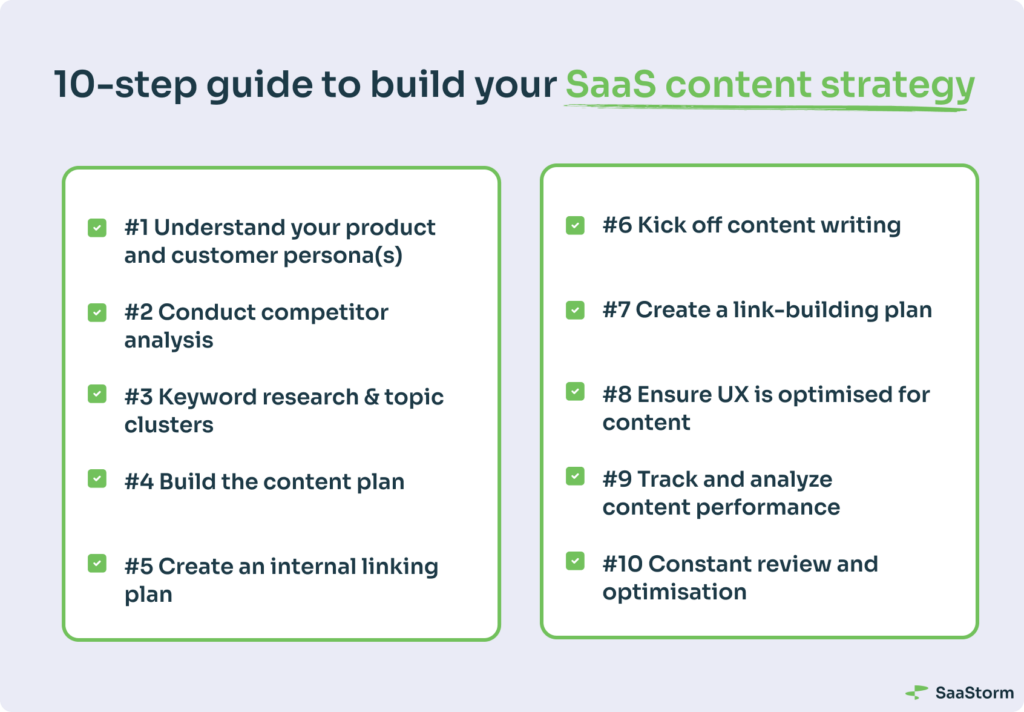
#1 Understand your product and customer persona(s)
Does your content marketing team understand your product? And do they know who they’re writing for? If your answer to both of those was ‘No,’ then take a step back and ensure they do. Content that’s created without true understanding of your offering and audience might as well not exist.
Here’s how we do it at SaaStorm:
- Product understanding: We dive deep into the SaaS product’s use case, identifying and mapping its value to customer pain points.
- Customer persona: We run in-depth discovery calls and listen to real customer conversations to understand what drives them, what keeps them up at night, and how your product fits into their lives.
Remember! Knowing your customer is about more than just demographics — it’s about getting into their mindset and tailoring content that speaks to their specific needs.
#2 Conduct competitor analysis
You’re not working in a vacuum—understanding what your competitors are doing is crucial.
At SaaStorm, we take a methodical approach:
- Content review: We examine their content, including use case pages, blog publication frequency, and keyword targeting.
- Site structure: We dig into their website layout and how to analyse they organise critical information.
- Marketing spend: We look at how much they invest in content and where they focus their efforts.
Once we have the complete picture, we identify gaps in their strategy — areas where they’re failing. That’s where you can make your move.
#3 Keyword research & topic clusters
Keyword research isn’t just about high search volume—it’s about finding the terms your audience is using.
This is what our process looks like:
- Keyword analysis: We focus on search volume (SV: how much your audience is searching for something), keyword difficulty (KD: how difficult it is to rank high with that keyword), and target countries.
- Content mapping: Using Miro, we visually organise topic clusters to ensure every piece of content fits into a broader, strategic plan.

This structured approach positions you as an authority, with content that’s easy to find and valuable to your audience.
#4 Build the content plan
A content plan is the foundation of your strategy. Here are the steps we use:
- Pillar pages and supporting content: We build out the core topics and supporting articles to boost visibility and drive leads.
- Content calendar: We organise everything into a calendar using tools like Google Sheets or Airtable to ensure consistency.

Execution tools: We rely on ClickUp or Asana for project management to stay on track.

#5 Create an internal linking plan
Internal linking is key for SEO, and we take it seriously:
- Linking Strategy: Every article in a topic cluster is linked to the central pillar page.
- SEO Power: This approach shows Google that your site covers topics in-depth, boosting rankings and authority.
#6 Kick off content writing
Creating high-quality, engaging content that drives MQLs for SaaS companies doesn’t happen by chance. It requires a structured, step-by-step process. Here’s how SaaStorm ensures content meets both reader expectations and SEO standards:
- Do keyword research: We begin by pinpointing high-intent keywords using tools like SEMrush, Ahrefs, and Google Keyword Planner. Our focus is on search volume and relevance, particularly within the SaaS space.
- Check competitors: We analyse competitor content to see what’s performing well and identify gaps we can exploit, positioning your content to stand out.
- Write a content brief: A detailed content brief is the foundation of every successful piece. At SaaStorm, our briefs cover everything, including:
- Meta title and description guidelines
- H1 and URL requirements
- Word count targets
- First draft and final submission deadlines
- Target audience and content goals
- Style guide and company positioning
- Decision journey stage (TOFU, MOFU, BOFU)
- A primary keyword and at least ten secondary keywords
- Competing content analysis
- Internal link suggestions
- AI content detection checks
- SurferSEO report link
- Google Drive folder for images
- A detailed article outline, including H2s and H3s
- Align with the Client: We don’t move forward until we’re aligned. At SaaStorm, we collaborate closely with our clients to ensure the content brief aligns with their goals and vision before any writing begins.
#7 Create a link-building plan
Backlinks are critical for improving your domain authority and ranking for competitive keywords. At SaaStorm, we don’t take chances with link-building—we work with top-tier agencies like LinkBuilder.io to secure high-quality backlinks for:
- The homepage: To boost overall site authority.
- Product pages: To rank for high-value keywords.
- New content: To help new blog posts and pages gain visibility quickly.
Building a link-building plan is essential for making sure your content reaches its full potential in search rankings.
#8 Ensure UX is optimised for content
Great content must be supported by an optimised user experience (UX). Knowing how to create a website content strategy improves your site’s ability to convert visitors into leads by optimising its structure and content.
Blog layout and structure can make or break engagement. At SaaStorm, we focus on:
- Categories and design: Ensuring blog posts are well-categorised, easy to navigate, and visually appealing.
- Author information and TOCs: Including author bios and sticky tables of contents to improve credibility and user engagement.
- CMS platforms: For flexibility and growth potential, we recommend robust platforms like WordPress, HubSpot CMS, and Webflow. We’ve successfully built blogs and templates for clients like OneUp Sales and GetReditus, tailoring the CMS to their needs.
Working with SaaStorm is like having an in-house team that truly understands your needs. Their responsiveness and willingness to assist, along with their valuable feedback, make them an invaluable B2B SaaS marketing agency. What sets SaaStorm apart is their commitment to tailoring their approach to us as a client. As we are bootstrapped we don’t have the resources of some of the enterprise clients they have.
– Joran Hofman, Founder at Reditus
Optimising your content’s UX is essential to keeping users engaged and improving SEO rankings.
#9 Track and analyze content performance
Creating content is only half the battle. Tracking its performance is where you’ll find real insights. At SaaStorm, we use:
- Google Analytics 4, Google Search Console, and SEMrush: To track traffic, keyword rankings, and engagement metrics across all content.
- Regular adjustments: Content performance isn’t static. We regularly analyse the data to tweak, update, and optimise content for even better results.
If you’re not analysing, you’re guessing — and that’s no way to grow. We’ll go more in-depth in the next section, but tracking ongoing performance through these tools is how you can make real-time adjustments.
#10 Constant review and optimisation
A content strategy isn’t a “set it and forget it” process. At SaaStorm, we ensure long-term growth by:
- Updating Keywords: As search trends evolve, so does your keyword strategy. We monitor competitor activity and industry changes to keep you ahead.
- Content Audits: We conduct regular audits to spot content that needs updating, re-optimization, or even pruning.
Remember! Continuous optimisation is what separates stagnant content from content that drives results over the long haul.
After following these ten steps to build your SaaS content strategy, the next question is: How do you know it’s working? To ensure your strategy delivers real, measurable results, you need to track the right metrics. Let’s take a look at the key metrics that will show whether your content is driving the impact you’re aiming for.
Key metrics to measure the success of your SaaS content strategy
Once you’ve tracked the initial performance of your content, it’s essential to understand which metrics matter most for long-term success. Here are the key metrics you need to measure—and how to use them to refine your content strategy over time.
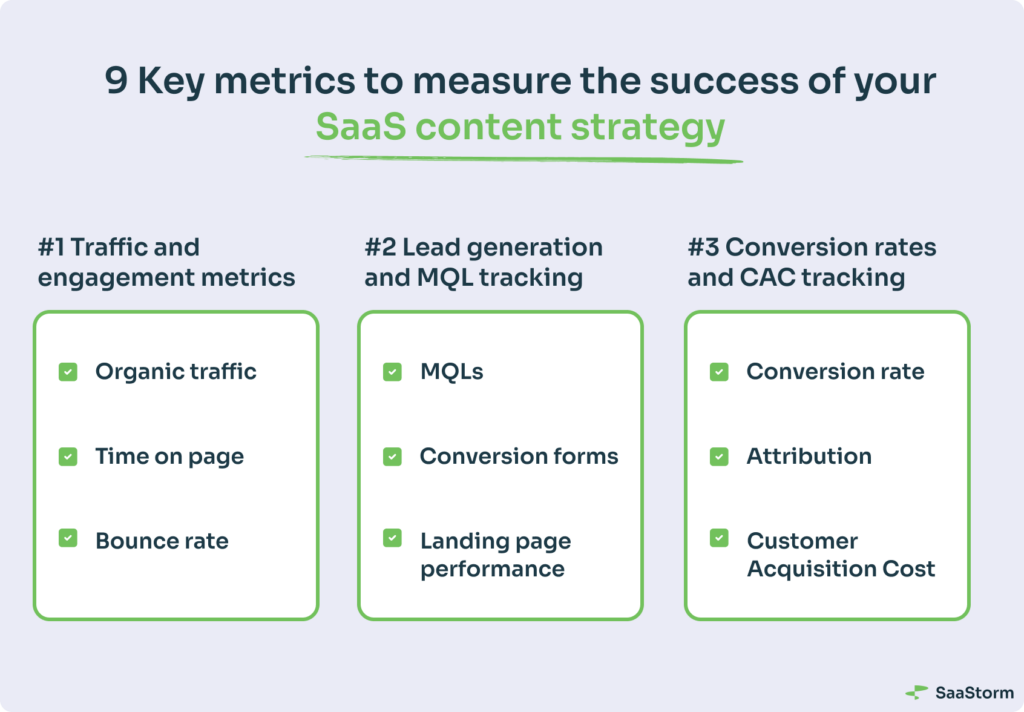
Traffic and engagement metrics
Traffic and engagement metrics give you insight into how well your content attracts and engages users over time. Here’s how to measure it:
- Organic traffic: Track the number of visitors coming from search engines using Google Analytics.
- Time on page: Measure how long visitors stay on your content, indicating engagement.
- Bounce rate: Monitor how many users leave your site after viewing one page, a sign that content may need more internal links or a stronger hook.
Lead generation and MQL tracking
Driving leads is the ultimate goal of SaaS content. Here’s how to measure your success:
- MQLs (Marketing Qualified Leads): Track the number of MQLs generated by specific content assets.
- Conversion forms: Monitor conversion rates of forms or CTAs within your content.
- Landing page performance: Analyze the conversion rates of landing pages tied to specific content.
Conversion rates and customer acquisition cost (CAC)
Ultimately, content should drive conversions and reduce customer acquisition costs. Here’s how to measure it:
- Conversion rate: Track the percentage of visitors who convert through content.
- Customer Acquisition Cost (CAC): Measure how much it costs to acquire a customer through content marketing.
- Attribution: Use multi-touch attribution to see how each piece of content contributes to the sales journey.
How SaaStorm generated 200+ MQLs for Lingio with SaaS content strategy
Lingio needed more than just a content strategy — they needed to transform their entire approach to lead generation. Shifting from outbound reliance to sustainable inbound demand required a content plan that delivered measurable growth.
Objective
Lingio’s goal was simple: stop depending on outbound leads and build a strong inbound demand generation engine through content marketing.
Our Strategy
Here’s how SaaStorm built a content strategy that turned Lingio’s goals into reality:
- Extensive keyword research: We targeted high-value search terms that aligned with Lingio’s ideal customers and product offerings.
- Topic clusters: We organised the content around pillar pages and supporting articles, ensuring a structured, SEO-friendly approach.
- Content calendar and SEO optimisation: We developed a detailed content calendar with SEO as the primary focus for production. Every piece was optimised to rank and perform.
- Ongoing SEO optimisation: We didn’t stop at publishing. Regular audits, strategic internal linking, and continuous performance optimisation were key parts of our long-term strategy.
Results
The numbers speak for themselves:
- 500% Organic Traffic Growth

- 11x Increase in Incoming Leads
- 36K+ Organic Clicks on blog pages

- 300+ Keywords Ranked in Google’s top 10
- 200+ MQLs Generated through organic search, contributing to 60% of Lingio’s sales pipeline
The success Lingio experienced with SaaStorm’s strategic approach isn’t a one-off — this is the kind of impact a data-driven content strategy can have when it’s done right. Now, let’s talk about how you can empower your SaaS growth using these same proven methods.
I’m very impressed with the results we’ve achieved together with the SaaStorm team. Our organic traffic has grown by 500% in just 6 months, leading to an 11x increase in incoming leads.
– Fredrik Selander, Head of Marketing at Lingio
Empower your SaaS growth with a data-driven content strategy
A successful content strategy is the backbone of SaaS marketing, driving organic traffic, generating qualified leads, and boosting your overall MRR.
When you adopt a data-driven, structured approach like the one outlined here, you can create a sustainable flow of inbound leads and position your SaaS company as an authority in your industry.
At SaaStorm, we always start with a 2-week discovery phase to analyse your current performance and plan for growth. This begins with a 1-hour call to set goals and discuss your monthly budget, allowing us to tailor the action plan to fit your needs.
After two weeks of in-depth analysis, we present our findings in a 1.5-hour session and provide a comprehensive report. You can use these insights as you see fit—there’s no ongoing commitment required.
Here’s what you’ll receive after two weeks:
• Competitor gap analysis
• Organic growth opportunities
• New topic cluster mapping
• A content plan with 20+ topics
• An internal linking plan
• An external backlink plan
• SEO tips and tricks for your website
• A detailed 3-month marketing action plan
All of this is available for a fixed price of €2,990 — an incredible starting point for your content strategy. No commitments after. You can learn more here.
Ready to elevate your SaaS content strategy? Partner with a B2B SaaS content marketing agency like SaaStorm to build a comprehensive content plan that aligns with your business goals and delivers real results.
Contact us today to start driving more MQLs and scale your SaaS business.
Frequently Asked Questions
Creating a B2B content strategy involves understanding your target market’s needs and creating content that engages them throughout the buyer’s journey. Start by defining your goals, researching competitors, and crafting a plan that educates and builds trust with your audience.
To create a blog content strategy, you should focus on high-quality, SEO-optimised posts that target the right keywords. Organise your content around topic clusters and use a content calendar to ensure consistency and relevance to your audience.
Creating a content strategy for a website involves structuring content that not only answers your audience’s questions but also ensures smooth navigation. A clear content hierarchy, combined with SEO best practices, helps improve user engagement and search rankings.
A digital content strategy covers various online platforms, from blogs to social media. Start by identifying which channels your audience uses. Then, repurpose content to suit each platform’s strengths, ensuring consistency and engagement across all channels.
A successful content marketing strategy begins with understanding your audience’s pain points, setting clear, measurable goals, and delivering valuable, consistent content that resonates. Continuously optimise your strategy based on performance metrics and feedback.
To create a good content strategy, you need to focus on high-quality, engaging content that solves your audience’s problems. Make sure you research their pain points, plan out your content thoroughly, and always keep SEO in mind to boost visibility.
Creating an SEO content strategy involves identifying high-intent keywords, optimising on-page SEO factors like meta tags, and building an internal linking structure. Regular audits and performance tracking will ensure your content continues to rank and attract traffic.


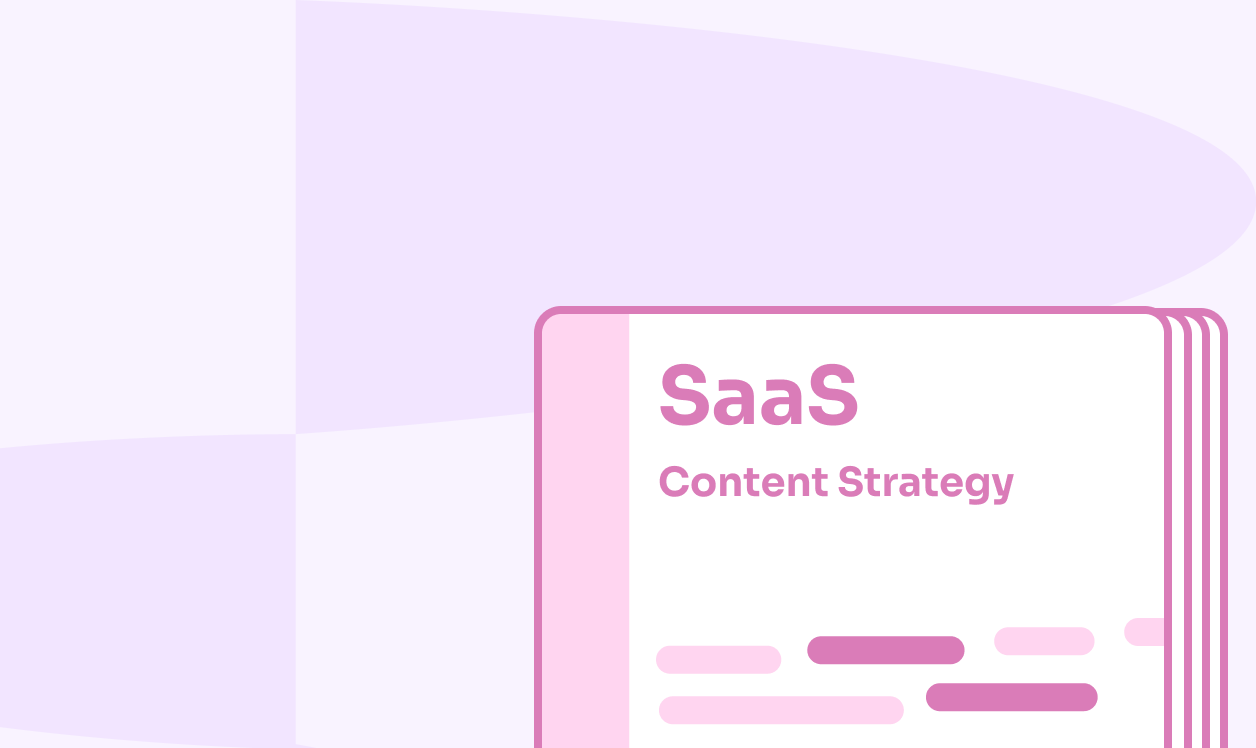
 SaaStorm experts in your inbox.
SaaStorm experts in your inbox.


